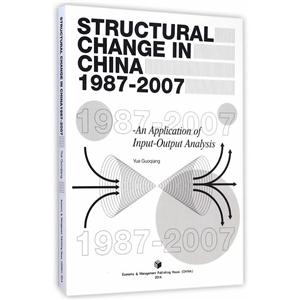扫一扫
关注中图网
官方微博
本类五星书更多>
-
>
蜜蜂的寓言:私人的恶德,公众的利益
-
>
世界贸易战简史
-
>
日本的凯恩斯:高桥是清传:从足轻到藏相
-
>
近代天津工业与企业制度
-
>
货币之语
-
>
眉山金融论剑
-
>
图解资本论
中国经济结构的变化 : 1987~2007 : 投入产出技术的应用 版权信息
- ISBN:9787509635506
- 条形码:9787509635506 ; 978-7-5096-3550-6
- 装帧:一般胶版纸
- 册数:暂无
- 重量:暂无
- 所属分类:>>
中国经济结构的变化 : 1987~2007 : 投入产出技术的应用 本书特色
岳国强所著的《中国经济结构的变化(1987-2007 投入产出技术的应用)(英文版)》是1978-2007年中国 经济结构转型的专业领域研究课题成果,作者运用投 入产出模型6章的篇幅做出分析,探讨了中国经济的 总体结构转变、资源分析等问题,本书视角独特,分 析到位,结构合理,全书用英文书写,对于我国海派 产业价值管理具有重要的理论意义和实践意义。
中国经济结构的变化 : 1987~2007 : 投入产出技术的应用 内容简介
岳国强所著的《中国经济结构的变化(1987-2007 投入产出技术的应用)(英文版)》是1978-2007年中国 经济结构转型的专业领域研究课题成果,作者运用投 入产出模型6章的篇幅做出分析,探讨了中国经济的 总体结构转变、资源分析等问题,本书视角独特,分 析到位,结构合理,全书用英文书写,对于我国海派 产业价值管理具有重要的理论意义和实践意义。
中国经济结构的变化 : 1987~2007 : 投入产出技术的应用 目录
Chapter 1 Introduction
1.1 The Purpose and Outline of the Study.
1.2 Economic Structure
1.3 Methodology
1.4 China' s Input-Output Tables
1.5 Literature Review
Chapter 2 General Structural Changes in China' s Economy
2.1 Introduction
2.2 Measurement of Structural Change
2.3 General Structural Change
2.3.1 Structural Change in Output
2.3.2 Structural Change in Value-added
2.3.3 Structural Change in Personal Consumption
2.4 Changes in Production Structure
2.4.1 Input Coefficient Changes
2.4.2 Output Coefficient Changes
2.5 Conclusions
Chapter 3 Sources of Output Change
3.1 Introduction
3.2 Methodology
3.2.1 Exact Decomposition Method
3.2.2 Approximate Decomposition Method
3.2.3 Decomposition of Technological Change
3.3 Comparison of Results
3.4 Sources of Output Change in China
3.4.1 Sources of Output Change for Six Main Sectors
3.4.2 Sources of Output Change in 37 Sectors
3.5 Conclusions
Chapter 4 Structural Change in Intersectoral Transactions
4.1 Introduction
4.2 Methodology
4.2.1 The Basic Principle of the RAS Method
4.2.2 The Explanation and Measurement of r and s
4.2.3 The Biproportional Filter Method
4.2.4 Differences between the RAS and the BF
4.2.5 The Two-Stage Biproportional Filter Method
4.3 Structural Change in Intersectoral Transactions in China
4.3.1 The One-Stage Biproportional Filter
4.3.2 The Two-Stage Biproportional Filter
4.4 Conclusions
Chapter 5 Intersectoral Linkages and key Sectors
5.1 Introduction
5.2 Methodology
5.2.1 Traditional Methods
5.2.2 Hypothesis Extraction Methods
5.2.3 Summary
5.2.4 Indices of the Overall Intersectoral Interdependence
5.3 Intersectoral Linkages and Key Sectors of China
5.3.1 General Tendency in Intersectoral Linkages
5.3.2 Intersectoral Interdependence for 37 Sectors
5.3.3 Comparison of the Results
5.3.4 Overall Intersectoral Interdependence and Key Sectors
5.4 Conclusions
Chapter 6 Conclusions
Appendix A Classification and Labels of the Sectors
Appendix B Formula of Chapter 5
Appendix C Ranking of Output for 2007
References
1.1 The Purpose and Outline of the Study.
1.2 Economic Structure
1.3 Methodology
1.4 China' s Input-Output Tables
1.5 Literature Review
Chapter 2 General Structural Changes in China' s Economy
2.1 Introduction
2.2 Measurement of Structural Change
2.3 General Structural Change
2.3.1 Structural Change in Output
2.3.2 Structural Change in Value-added
2.3.3 Structural Change in Personal Consumption
2.4 Changes in Production Structure
2.4.1 Input Coefficient Changes
2.4.2 Output Coefficient Changes
2.5 Conclusions
Chapter 3 Sources of Output Change
3.1 Introduction
3.2 Methodology
3.2.1 Exact Decomposition Method
3.2.2 Approximate Decomposition Method
3.2.3 Decomposition of Technological Change
3.3 Comparison of Results
3.4 Sources of Output Change in China
3.4.1 Sources of Output Change for Six Main Sectors
3.4.2 Sources of Output Change in 37 Sectors
3.5 Conclusions
Chapter 4 Structural Change in Intersectoral Transactions
4.1 Introduction
4.2 Methodology
4.2.1 The Basic Principle of the RAS Method
4.2.2 The Explanation and Measurement of r and s
4.2.3 The Biproportional Filter Method
4.2.4 Differences between the RAS and the BF
4.2.5 The Two-Stage Biproportional Filter Method
4.3 Structural Change in Intersectoral Transactions in China
4.3.1 The One-Stage Biproportional Filter
4.3.2 The Two-Stage Biproportional Filter
4.4 Conclusions
Chapter 5 Intersectoral Linkages and key Sectors
5.1 Introduction
5.2 Methodology
5.2.1 Traditional Methods
5.2.2 Hypothesis Extraction Methods
5.2.3 Summary
5.2.4 Indices of the Overall Intersectoral Interdependence
5.3 Intersectoral Linkages and Key Sectors of China
5.3.1 General Tendency in Intersectoral Linkages
5.3.2 Intersectoral Interdependence for 37 Sectors
5.3.3 Comparison of the Results
5.3.4 Overall Intersectoral Interdependence and Key Sectors
5.4 Conclusions
Chapter 6 Conclusions
Appendix A Classification and Labels of the Sectors
Appendix B Formula of Chapter 5
Appendix C Ranking of Output for 2007
References
展开全部
书友推荐
- >
伯纳黛特,你要去哪(2021新版)
伯纳黛特,你要去哪(2021新版)
¥16.9¥49.8 - >
名家带你读鲁迅:故事新编
名家带你读鲁迅:故事新编
¥13.0¥26.0 - >
李白与唐代文化
李白与唐代文化
¥9.9¥29.8 - >
烟与镜
烟与镜
¥18.3¥48.0 - >
诗经-先民的歌唱
诗经-先民的歌唱
¥14.5¥39.8 - >
伊索寓言-世界文学名著典藏-全译本
伊索寓言-世界文学名著典藏-全译本
¥6.7¥19.0 - >
名家带你读鲁迅:朝花夕拾
名家带你读鲁迅:朝花夕拾
¥10.5¥21.0 - >
月亮与六便士
月亮与六便士
¥19.1¥42.0
本类畅销
-
无退休社会
¥30.8¥48 -
都是爱书的人-上海书评选萃
¥13.2¥35 -
郎咸平说改革如何再出发
¥11.3¥38 -
从农业1.0到农业4.0:生态转型与农业可持续
¥41.8¥68 -
经济改革和对外开放卷-田纪云文集
¥23.5¥75 -
改革共识与中国未来
¥22¥38
浏览历史
DSP技术原理与应用系统设计
¥66.6¥79.0职业院校德育实践活动创新设计
¥16.0¥28.8物理学家用微分几何-(第二版)-典藏版
¥138.6¥198.0计量经济学
¥9.1¥23.8智能检测技术与传感器
¥24.0¥32.0

















